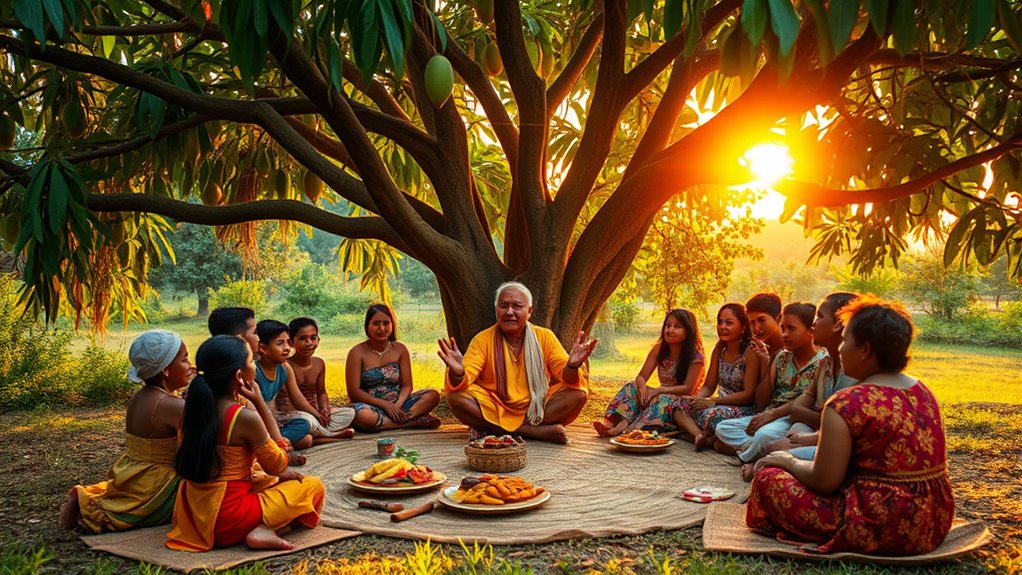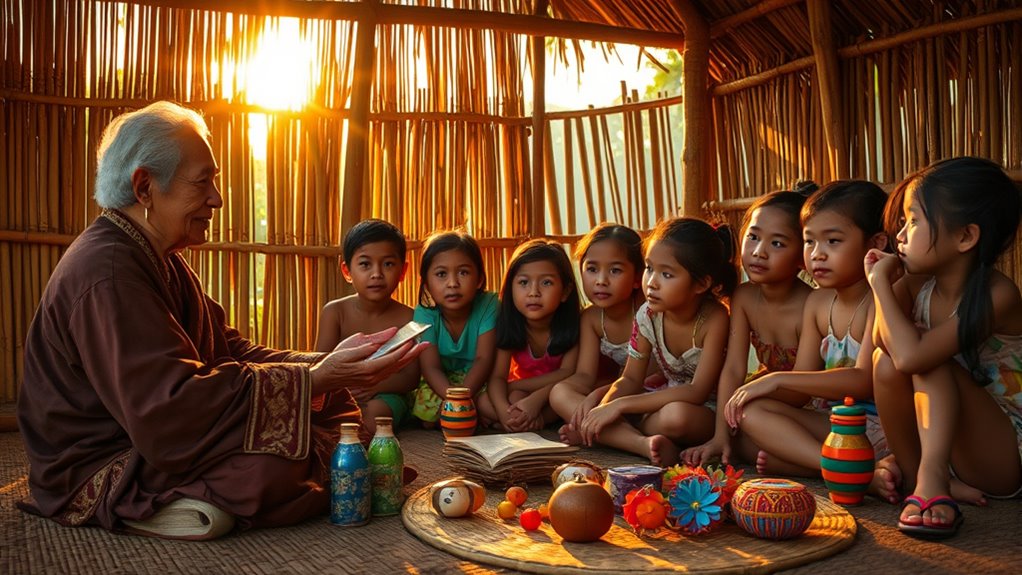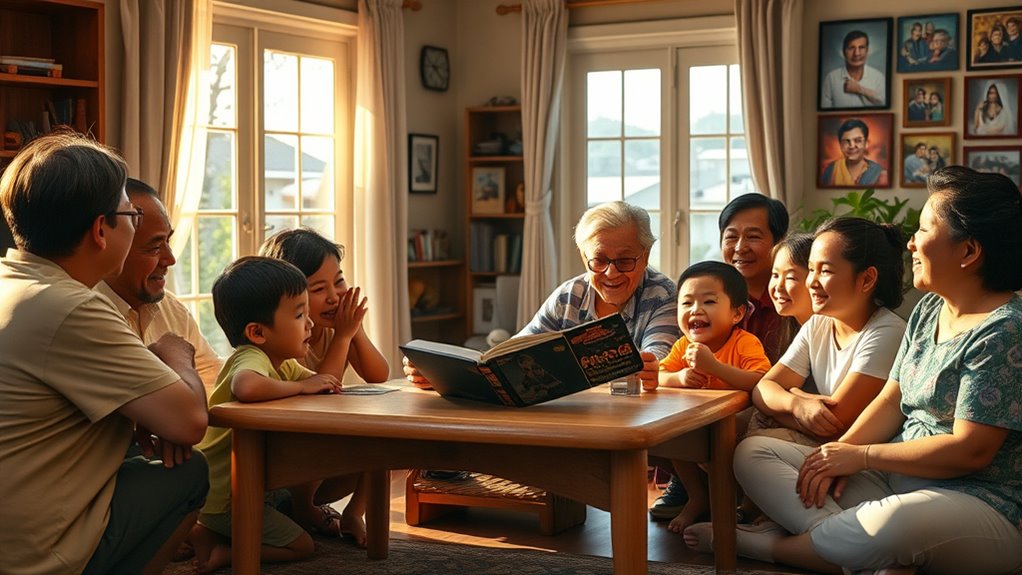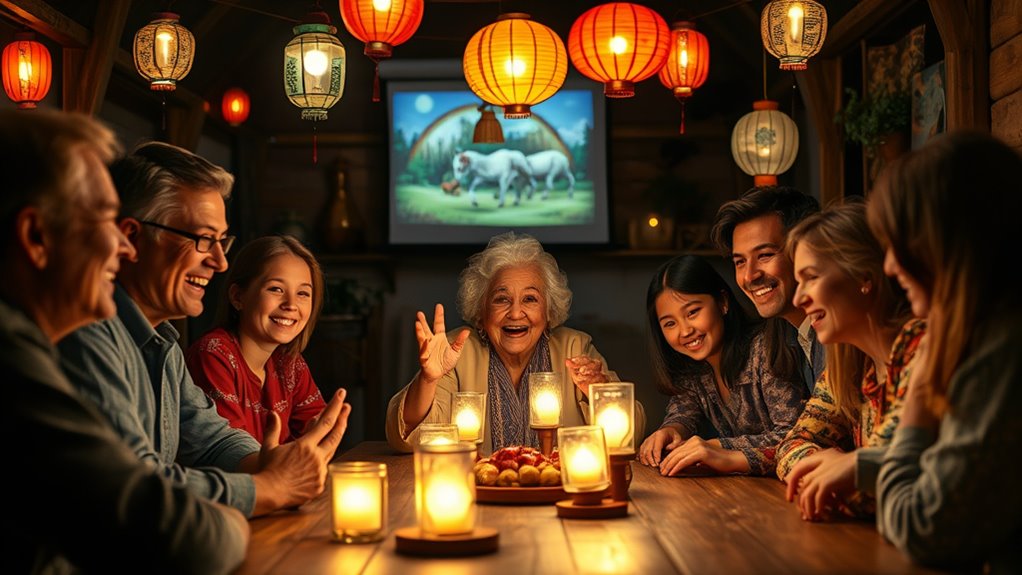Filipino storytelling shapes relationships by weaving shared narratives that foster community bonds and reinforce cultural values. Through oral traditions and folklore, you connect with your heritage and gain insights into social issues. Storytelling evokes empathy, enabling you to relate to others’ experiences, while also bridging generational gaps. As you engage with contemporary adaptations, you find new ways to strengthen these connections. Discover how these rich narratives continue to influence your relationships in today’s world.
Key Takeaways
- Filipino storytelling fosters community bonds by sharing common narratives that reinforce cultural values and social unity.
- Oral traditions preserve familial connections, allowing grandparents to pass down cultural knowledge and traditions to younger generations.
- Emotional resonance in narratives enhances empathy, creating relatable characters that strengthen relationships within the community.
- Contemporary adaptations of stories bridge generational gaps, engaging diverse audiences and fostering a shared sense of belonging.
- Storytelling acts as a social commentary, addressing societal issues and guiding behavior, ultimately enriching interpersonal relationships.
Historical Roots of Filipino Storytelling

Filipino storytelling has deep historical roots that trace back to the Austronesian culture, which spread from Taiwan over 4,000 years ago.
You’ll find that early narratives often revolved around community experiences, reinforcing shared values and social bonds. As trade and migration flourished, influences from Malay and Chinese cultures enriched these stories, adding layers of complexity.
Initially rooted in myths and legends, Filipino storytelling aimed to explain natural phenomena and the creation of the world. The oral tradition played a vital role, ensuring these tales were passed down generations, highlighting the spoken word’s significance.
Even after colonization, the essence of these narratives remained, adapting while preserving their core themes of identity and resilience.
The Role of Folklore in Building Community Bonds

While many might see folklore as merely a collection of old tales, its true power lies in building community bonds.
Folklore serves as social commentary, addressing societal issues and teaching moral lessons that resonate within your community. Rituals, like asking permission from spirits before cutting trees, foster unity and shared experiences, creating common narratives that connect you with others.
Folklore acts as a mirror to society, offering moral lessons and fostering unity through shared rituals and narratives.
As you participate in these traditions, you help preserve cultural heritage and promote respect for diverse beliefs. Folklore also teaches children about values while reinforcing family ties through ancestral respect.
Ultimately, these stories cultivate trust, guide behavior, and enhance social cohesion, making folklore an essential tool for strengthening the bonds that hold your community together.
Intergenerational Connections Through Storytelling

Stories not only strengthen community bonds but also weave connections across generations. When grandparents share tales, they pass down cultural values and familial traditions, creating a rich tapestry of kinship.
You might notice how these narratives preserve experiential knowledge, allowing younger generations to adapt to cultural nuances. Events like fiestas foster storytelling among diverse age groups, reinforcing respect for elders as the keepers of family lore.
Modern technology, too, plays a role—connecting distant family members through digital platforms. By sharing stories, you engage in collaborative learning, enriching your understanding of heritage.
In urban settings, age diversity enhances this experience, ensuring that every voice contributes to a vibrant narrative, bridging the gap between past and present.
Emotional Resonance and Empathy in Narratives

Emotional resonance in narratives creates a powerful connection that draws you into the heart of Filipino culture. As you listen to stories, you deepen your family ties and foster empathy within your community.
These narratives serve as cultural anchors, enhancing your appreciation for heritage and promoting unity among diverse ethnic groups. Through relatable characters facing love, joy, and resilience, you find yourself emotionally engaged, encouraging empathy with their struggles and triumphs.
The authentic portrayal of these experiences strengthens your bond to the community, reinforcing shared identity and emotional depth. By understanding these narratives, you gain insights into emotional expression, helping you navigate relationships and build a stronger sense of belonging within Filipino culture.
Storytelling as a Tool for Cultural Education

Through the rich tapestry of Filipino storytelling, you discover a dynamic tool for cultural education that not only preserves heritage but also imparts crucial life lessons.
These stories often weave traditional folktales and fables, highlighting values like friendship and family togetherness. By blending traditional narratives with modern techniques, storytelling engages diverse audiences and promotes community bonding.
As you explore these tales, you gain moral insights that reinforce virtues such as humility and gratitude. This process enhances critical thinking and nurtures imagination, allowing you to examine different scenarios and their consequences.
Furthermore, integrating stories into education fosters cultural awareness, ensuring that Filipino identities thrive even among those living abroad, creating an essential connection to heritage.
The Influence of Family Dynamics on Storytelling

While family dynamics shape how narratives are shared, they also influence the content and impact of those stories. In Filipino families, extended networks enrich storytelling, as multiple generations collaborate to pass down cultural traditions.
Grandparents often play a crucial role, ensuring these narratives remain alive. The respect for elders reinforces their importance in transmitting wisdom and values, while shared family experiences foster communal bonding.
Grandparents are vital in preserving narratives, imparting wisdom and fostering deep family connections through shared experiences.
However, close-knit family ties can sometimes stifle individual expression, complicating how personal stories are conveyed. Trust and open communication are essential for effective storytelling, yet emotional barriers may hinder full expression.
Ultimately, these dynamics create a unique tapestry of stories that reflect both traditional values and the evolving nature of family relationships.
Contemporary Adaptations and Their Impact on Relationships

As contemporary adaptations of Filipino stories evolve, they markedly reshape social relationships by bridging generational gaps and fostering community connections.
You’ll notice how diverse adaptations like *Zsa Zsa Zaturnnah* engage various audiences, creating a shared sense of belonging. These stories reflect cultural identities, encouraging empathy and understanding among viewers.
With innovative mediums like multimedia and web novels, you can explore narratives that spark conversations, enhancing connections between readers.
The emotional impact of theater productions, such as *Tatarin*, provides live interactions that deepen bonds. Movies like *Maynila: Sa mga Kuko ng Liwanag* not only address social issues but also promote cultural dialogue, enriching relationships within and outside Filipino communities.
Through these adaptations, storytelling truly becomes a bridge between cultures and generations.
The Therapeutic Power of Storytelling in Social Cohesion

Storytelling possesses a unique therapeutic power that fosters social cohesion within Filipino communities. It transforms negative trauma into constructive energy, promoting resilience and healing.
By sharing oral traditions, you and your community create a shared history that unites everyone. Engaging in storytelling allows for deeper emotional connections, validating individual experiences while enhancing collective understanding.
This process helps you address historical traumas, forming alliances based on common values and experiences. As you share narratives, you also plan actions for social change, reinforcing a sense of belonging.
Integrating storytelling with other therapeutic practices, like visual arts, further enriches emotional expression.
Ultimately, storytelling not only preserves cultural roots but also strengthens community ties, reinforcing solidarity and continuity with the past.
Frequently Asked Questions
How Do Storytelling Practices Vary Across Different Filipino Regions?
Storytelling practices across different Filipino regions vary considerably. You’ll notice that each region boasts unique folklores and legends, shaped by local customs and values.
In rural areas, oral traditions thrive, while urban centers embrace modern media. Regional languages enrich narratives, with proverbs adding depth.
These stories often reflect the importance of family and community, highlighting moral lessons that resonate with listeners, bridging generational gaps, and preserving cultural identity through shared experiences.
What Role Does Humor Play in Filipino Storytelling?
Humor plays an essential role in Filipino storytelling by engaging you and making narratives more memorable. It often incorporates clever wordplay and irony, helping you relate to everyday situations.
Through laughter, you find a shared connection, reinforcing community ties. Humor also allows storytellers to address serious issues without confrontation, making social commentary accessible.
Are There Specific Themes Prevalent in Filipino Folktales?
As you sit under a mango tree, a grandmother begins a tale, and you realize Filipino folktales are rich with themes.
Creation myths spark imagination about origins, while hero tales inspire bravery. You hear about supernatural beings, reminding you of the magic in everyday life.
Each story carries moral lessons, guiding right from wrong, and reflects the cultural diversity of the Philippines, connecting you to its vibrant heritage in every narrative shared.
How Has Globalization Affected Filipino Storytelling Traditions?
Globalization’s impacted Filipino storytelling traditions in several ways.
You’ll notice traditional narratives blending with modern themes, as Western influences seep in. Digital media platforms allow you to access stories from anywhere, expanding their reach.
While English becomes more prevalent, it opens doors for international audiences but risks diluting local uniqueness.
Despite these changes, efforts to preserve traditional methods persist, ensuring that Filipino culture remains vibrant amidst evolving storytelling practices.
What Modern Platforms Are Popular for Sharing Filipino Stories?
Imagine a vibrant tapestry woven with threads of stories, each representing a different platform.
You’ll find the TypeKita app, where writers craft chat-style novels that dance off the screen. Web novels invite you into immersive worlds, while Sari-Sari Storybooks nurture young minds.
Social media connects you to storytellers, and blogs create lively discussions.
These platforms aren’t just sharing tales; they’re breathing life into Filipino culture, ensuring its vibrant colors never fade.
Conclusion
In the tapestry of Filipino storytelling, threads of history, culture, and emotion intertwine, binding hearts and minds. Each tale whispered under the stars strengthens community ties, while the wisdom passed through generations sparks connections that light the path of understanding. As you embrace these narratives, you’re not just a listener; you’re a participant in a vibrant dance of empathy and resilience. So, let the stories flow, for in their embrace, you’ll find the essence of shared humanity and belonging.









